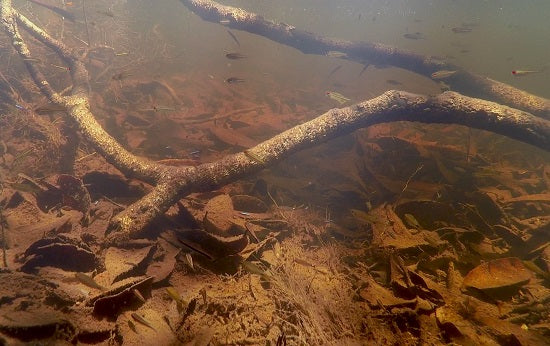- Continue Shopping
- Your Cart is Empty
Mumbling about "mulm"- a term from the hobby's "Golden Age"
I remember as a kid reading fish books. Like, I read all of the ones I could get my hands on.
Some were my dad's (yeah, he was a fish geek, too..it's genetic!), others were from the public library, or my own growing collection. Most were from the late 1950s and 1960's, because that was when the bulk of the major, amazing books on tropical fishes were published up until that point.

They were magical. It was a "Golden Age" for the tropical fish hobby, for sure. And you could sense it just by reading these charming books. You could almost feel the metal frame, slate-bottomed tanks of the day!

I read every book, from cover to cover. Memorized every passage. Savored every image. Studied each caption. Coveted every fish!

One word I remember seeing in many of these books was "mulm." It was a funny word. A sort of 1950's-60's-style catch-all expression for "stuff" that accumulates at the bottom of an aquarium.
It was- is- quite appropriate and descriptive!
To me, "mulm" is the freshwater equivalent of "detritus", which is used in the saltwater hobby extensively to describe the solid material that accumulates at the bottom of an aquarium as the end product of biological filtration.
"Mulm", however, is a bit more.
I think mulm is also that matrix of stringy algae, biofilms, and fine particles of "stuff" that tends to accumulate here and there in healthy aquariums, What's cool about this stuff is that, not only do you see it in aquariums- you see it extensively in natural ecosystems, such as Amazonian streams.

In the case of a "New Botanical" style aquarium, "mulm" is also the broken-down leaves and botanicals. It's a part of what we love call "substrate enrichment" in our aquariums. As botanicals break down- just like in nature, they create a diverse matrix of partially decomposing plant materials, pieces of bark, bits of algae, and some strings of biofilm.
In years past, those of us who favored "sterile-looking" aquaria would have been horrified to see this stuff accumulating on the bottom, or among the wood. Upon discovering it in our tanks, it would have taken nanoseconds to lunge for the siphon hose to get this stuff out ASAP! In our case, we embrace this stuff for what it is: A rich, diverse, and beneficial part of our microcosm. It provides foraging, "Aquatic plant "mulch", supplemental food production, a place for fry to shelter, and is a vital, fascinating part of the natural environment.

It is certainly a new way of thinking when we espouse not only accepting the presence of this stuff in our aquaria, but actually encouraging it and rejoicing in its presence! Why? Well, not because we are thinking, "Wow, this is an excuse for maintaining a dirty-looking aquarium!" No. We rejoice because our little closed microcosms are mimicking exactly what happens in the natural environments that we strive so hard to replicate. Granted, in a closed system, you must pay attention to water quality, but accepting decomposing leaves and botanicals as a dynamic part of a living closed system is embracing the very processes that we have tried to nurture for many years.
Sure, it's a very different aesthetic: Brown water, leaves, stringy algae films, and botanical debris. We may not want to have an entire bottom filled with this stuff...or, maybe we might!

Check your water parameters. Are you seeing surging nitrate levels? Do you have any detectible ammonia or nitrite? Are the fishes healthy, relaxed, and active? If the answer to the first two questions is "no", and the last is "yes"- then perhaps it's time to enjoy whats happening in your aquarium! To accept and understand that the aesthetic of a heavily botanical-influenced system is simply different than what we've come to perceive as "acceptable" in the general aquarium sense.
It's not for everyone.
It's not something that we are used to seeing. However, the feedback we've been getting from you- our customers- regarding the systems you've set up in this fashion is that they have created an entirely new perception and understanding of a freshwater aquarium. They've enabled us all to try a completely different aesthetic experience, to understand processes that occur naturally, which are of great benefit to the fishes we keep.

Since we've started Tannin, we hear a lot of stories from hobbyists of successful spawning and rearing of fishes that have proven challenging in the past. We've hear of hobbyists being extremely skeptical and, well- even a bit turned off by what was happening in their water- and then waking up one day and noticing that their fishes have never looked better- never acted more "naturally"- and that visitors to the fish room are fascinated by the "brown tank" that was recently set up...drawn to it. I've seen this before many times, myself.

I'm not sure why..I don't know if it's simply because these types of tanks are such a radical aesthetic departure from what we're used to, or if it's something more.
Perhaps, we're somehow drawn to their earthy, organic feel?
I'm not sure. But I do know that I'm enjoying my tanks, and so are many of you who have tried this approach. You're having a lot of fun- even with "mulm" in your tanks.
And that's what it's all about!
Stay engaged. Stay fascinated. Stay open-minded. Stay unafraid...
And Stay Wet.
Scot Fellman
Tannin Aquatics









Scott Fellman
Author